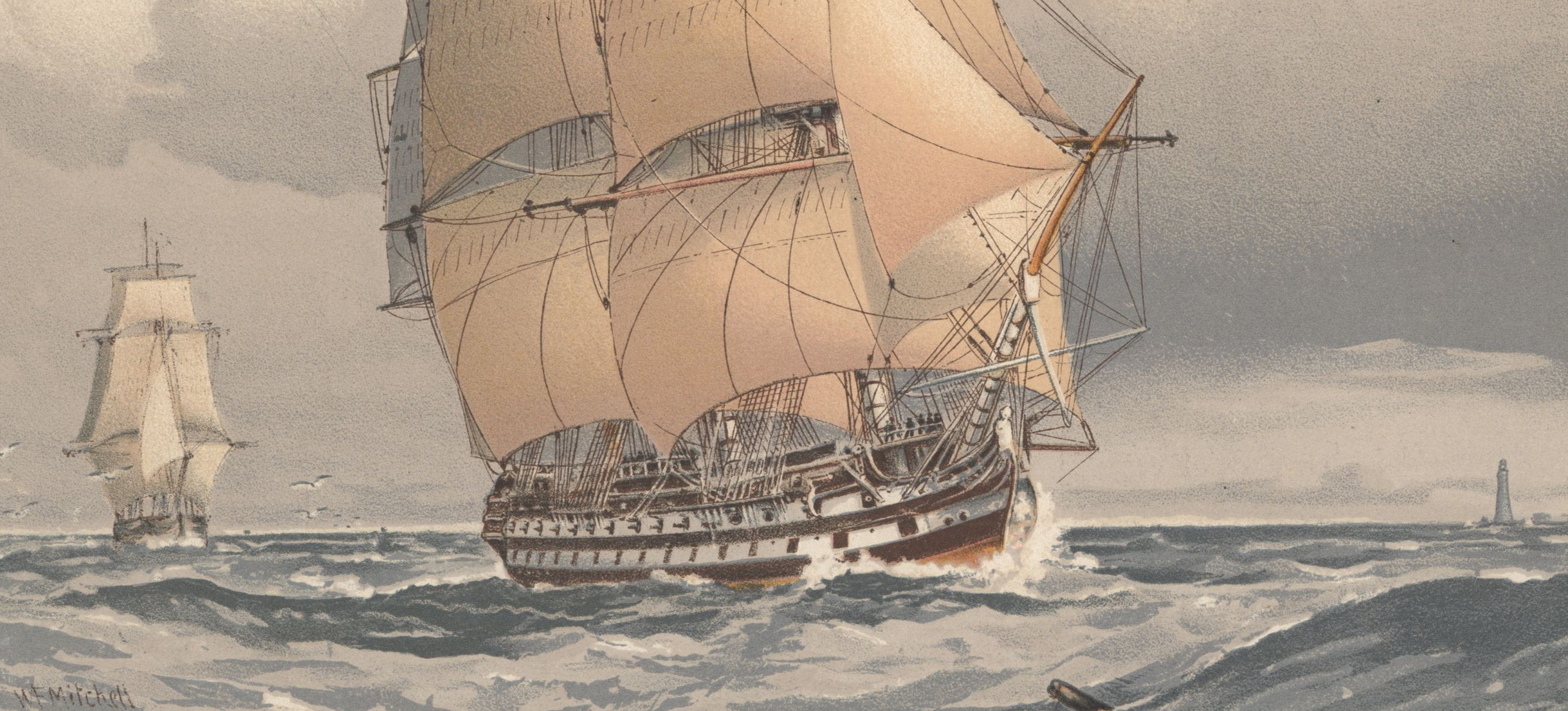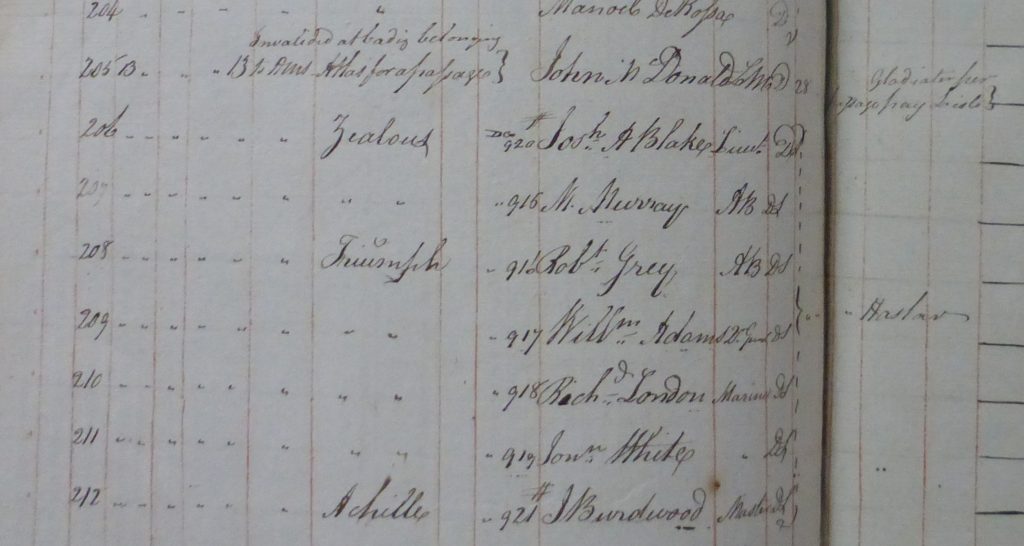
The Ceuta papers
5 April 2022HMS Centaur and Hood’s Boys
18 June 2022The Ceuta papers contain a large number of hints about our author and his role both in Ceuta and Cadiz. The evidence points to a Joseph Humphreys1 but we have yet to confirm this.
Our author records in his diary that he came home from Cadiz in the Antelope in company with Captain Ross Donelly so we started with the muster rolls of HMS Antelope which are held at the National Archives.2 These show the transport of Henry Wellesley and suite out to Cadiz as ambassador. They also record the names of ten people who were carried as Supernumaries on the return voyage.
- Captain Ross Donelly joined the Antelope on 4 March, with his servant Law Lyons. He was the former captain of HMS Invincible and is recorded as being invalided from HMS Bulwark back to Portsmouth where he was discharged on arrival on 28 March
- Below these two is a Ja(mes?) Humphries, the ‘former Purser of HMS Resistance‘ who also left the ship on its arrival in Portsmouth on 28 March.

There is then a long list of names of names of people ‘taken out of the Maria Primiera Portuguese 74 gun ship wrecked at Cadiz‘ and released to HMS Triumph a few days later.

This is followed by a list of others being invalided back to Portsmouth:
- John McDonald was a Land’s Man – LM – and is shown as ‘Invalided at Cadiz belonging to HMS Atlas for a passage‘. He was discharged on 28 March to HMS Gladiator, a convalescence ship. A Land’s Man was the lowest level of seaman and not an officer
- Below his name are seven other names all who were discharged to Haslar and were presumably sick or injured. One, a Joseph Blake, a Lieutenant from HMS Zealous may be the Lt Blake who is recorded as dying in 1810. Did he die in Haslar? Was he ill before he left Cadiz – perhaps – but the diary does not sound like the diary of a sick man
- The other people discharged to Haslar were all seamen or marines and therefore unlikely to be our author. The only other possibility is J Burdwood from Achilles who was a Master, but he too was released to Haslar
Other threads
Our author was of sufficiently good standing to dine (in company?) with the Governor of Ceuta which suggests that he was either an Officer or Warrant Officer.
He expresses concern ‘of course’ about the Zaragosa during the Cadiz storm. We know that the Saragossa, McKessock, was a Danish prize operating as a merchant vessel and that she was in Cadiz ‘bound to Lima’3. The ‘of course’ is tantalising: what was our author’s connection with the Saragossa (or Zaragosa)?
On arrival in Cadiz our author ‘avoided Quarantine … by declaring we brought letters of importance to the Commander in Chief which was true as far as By order of Admiral Viners (to whom an hour before delivered them) but not in the way they understood it …‘ It is unclear from this whether our author or a fellow-traveller (‘we’) was on a specific mission.
Working assumption
Our current hypothesis is that our author was probably the Joseph, Ja(mes?), Humphryes/Humphries4 whose name appears below that of Captain Donelly in the Antelope‘s Muster Rolls.
In late January 1809 HMS Resistance, a 44 gun frigate, Captain Charles Adam, was in Falmouth, rounding up the remnants of a convoy which had been scattered on its return from Cadiz.5 The Purser, a Joseph Mumford was accused of supplying ‘several of the ship’s company with spirits and charged the men or caused them to be charged with slops in order to reimburse himself.’ He then became ill.6
On 3 February 1809 Mumford was replaced aboard Resistance by the Purser of HMS Experiment, the guard ship at Falmouth, one Joseph Humphryes.7
We have been able to track Joseph’s trip on the Resistance, which was part of the Mediterranean fleet, along the coast of Spain and into the Mediterranean.8 On 22 December 1809 he was superceded aboard Resistance and transferred to HMS Spider, a 10-gun sloop, while in Messina ‘For a passage to England’.9. As a Warrant Officer, a Purser was attached to a specific ship and was not a ‘mobile grade’ and so he would have expected to make his way home to his ‘home port’ (possibly Falmouth in this case) at the end of his temporary secondment.
There the trail goes cold until Joseph appears in Cadiz on the Muster Roll for the Antelope at the beginning of March 1809. What happened in the two missing months, Jan/Feb 1810? Did he travel from Messina to Cadiz via Ceuta?
The muster roll for HMS Spider, then in company with HMS Grasshopper in Messina, has no record of him arriving aboard on 22 December 1809. 10 Spider arrived in Valetta on 29 December and seems to have remained there until she left Malta on 10 February, joining a convoy before returning to Pantalaria on 23 February.11
The Antelope Muster Roll records Joseph as leaving the ship at Portsmouth on 28 March 1810. On 3 April he is transferred to HMS Tromp, the hospital ship in Plymouth, ‘by Warrant’. He joined Tromp on 18th.12
The Ceuta papers and journal were written for a third party. Did that third party live in, or near Falmouth or did Joseph retire to Falmouth where his papers became part of a family’s archive for over 150 years before making their way to a car boot sale? There is no identifiable record in the Censuses of the existence of a specific Joseph Humphreys at the time.
There is one small wrinkle in the theory that Joseph is our author: his handwriting. Joseph signed the Muster Rolls with a beautifully crafted and formal signature. The Notes and journal, however, are very roughly written and there are few similarities with the signature.

Coincidences
Two curious coincidences have appeared during this work.
Captain Adam of the Resistance had once commanded HMS Sybille 48, the ship which later took the elusive d’Alvimart to Ceuta some time after 1810.
The Captain Donelly who travelled from Cadiz to Portsmouth with Joseph Humphryes in HMS Antelope, was replaced as captain of HMS Invincible on 6 April 1810 by none other than Captain Adam of HMS Resistance. We wonder whether Joseph Humphreys spoke with Donelly about his former captain on the voyage home, little knowing that he was telling Donelly about his successor.
We would welcome suggestions for other lines of enquiry …
- There are various different spellings of his name
- National Archives ADM 37/2484
- Lloyd’s List 30 March 1810
- The spelling varies in different sources. He signed the Muster Rolls for HMS Resistance ‘Joseph Humphryes’
- See separate section on the letters of Charles Adam both in Falmouth and later
- National Archives ADM 1/1452/130 and ADM 1/1452/135
- National Archives ADM 1/1452/135 and ADM 37/2544. The spelling in this source is ‘Josh Humphrys’
- ADM 37/2641
- ADM 37/2641
- ADM 37/2338
- ADM 51/2795 Captain’s Log
- ADM 37/2666
